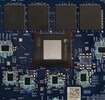Qualcomm Snapdragon X X1-26-100 vs Qualcomm Snapdragon X Elite X1E-00-1DE vs Qualcomm Snapdragon X Plus X1P-46-100
Qualcomm Snapdragon X X1-26-100
► remove from comparison
The 8-core Snapdragon X (X1-26-100) is an affordable ARM architecture processor for use in Windows laptops. Unveiled in Jan 2025, this Qualcomm SoC features 8 Oryon CPU cores running at up to 2.98 GHz, along with the 1.7 TFLOPS X1-45 iGPU and the 45 TOPS Hexagon NPU. The super-fast LPDDR5x-8448 memory controller, USB 4.0 support, TB 4 support and PCIe 4 support are all onboard as well.
Architecture and Features
The Oryon cores (2 clusters of essentially identical cores; 8 threads) are mostly based on Nuvia IP and reportedly make use of the ARM v8.7 microarchitecture. Much like modern AMD and Intel processors, the Snapdragon chip is compatible with USB 4 and thus with Thunderbolt 4 (with no eGPU support).
The X1-26-100 is based on the smaller die codenamed Purwa, unlike most X Elite and some X Plus processors. It is believed to have at least 8 PCIe 4 and 4 PCIe 3 lanes for connecting various kinds of devices. NVMe SSDs are supported with a throughput of up to 7.9 GB/s; furthermore, most laptops built around the chip are expected to have 16 GB of LPDDR5x-8448 RAM. There is also a 45 TOPS NPU present for accelerating AI workloads.
Performance
The CPU should be about 10% slower than its faster brother named X1P-42 due to the latter's higher CPU clock speeds. Generally speaking, a performance level similar to recent U-class Intel Core 5 chips is to be expected.
Graphics
The X1-45 used here delivers up to 1.7 TFLOPS of performance. Unlike the much faster 3.8 TFLOPS and 4.6 TFLOPS X1-85 iGPUs, this little guy here has much fewer unified shaders and runs at lower clock speeds, too. Games put it a little behind the GeForce MX350; this kind of performance is sufficient for older games and sub-900p resolutions only.
AVC, HEVC and AV1 video codecs can be both hardware-decoded and hardware-encoded whereas with VP9, only decoding is possible. The highest monitor resolution supported is UHD 2160p.
Power consumption
Expect to see anything between 15 W and 30 W under long-term workloads depending on the system and the power profile chosen. The number includes RAM power consumption.
The SoC is built with TSMC's N4P process for decent power efficiency, as of H1 2025.
Qualcomm Snapdragon X Elite X1E-00-1DE
► remove from comparison
The Snapdragon X Elite X1E-00-1DE is a pretty fast ARM architecture processor (SoC) for use in Windows mini-PCs and laptops. As the fastest X Elite chip in September 2024, the X1E-00-1DE has 12 Oryon CPU cores running at up to 4.3 GHz, along with the 4.6 TFLOPS Adreno X1-85 iGPU, the 45 TOPS Hexagon NPU and an impressively fast LPDDR5x-8448 memory controller delivering over 100 GB/s of throughput. USB 4.0, TB 4 and PCIe 4 are all onboard, too.
Three slower Snapdragon X Elite flavors exist, known as the X1E-84-100, X1E-80-100 and X1E-78-100.
Architecture and Features
The Oryon cores (3 clusters of equally powerful cores; 12 threads) are mostly based on Nuvia IP and they reportedly make use of the ARM v8.7 microarchitecture. Much like modern AMD and Intel processors, the Snapdragon chip is compatible with USB 4 and thus with Thunderbolt 4 however it does not appear to support eGPUs as of September 2024.
Like most X Elite and X Plus processors, the X1E-00-1DE is based on the larger die codenamed Hamoa. The processor is believed to have at least 12 PCIe 4 and 4 PCIe 3 lanes for connecting various kinds of devices. NVMe SSDs are supported with a throughput of up to 7.9 GB/s. There is also a 45 TOPS NPU present for accelerating AI workloads.
Performance
When all of the 12 cores are under load, they run at up to 3.8 GHz. The 4.3 GHz clock speed is only achievable under single-thread or dual-thread loads.
Based on this Notebookcheck review of a Samsung laptop powered by the X1E-84-100, a chip that's supposed to be just a hair's width slower than the X1E-00-1DE, the top-of-the-line Snapdragon processor should be almost as fast as the Core Ultra 7 155H in applications compiled for ARM while being up to 30% slower when executing x86 code.
Graphics
The 4.6 TFLOPS X1-85 iGPU has 1,536 unified shaders running at up to 1,500 MHz. It is reportedly (ChipsAndCheese) based on the significantly older Adreno 730 iGPU, rendering the X1-85 DX12-compatible but not DX12 Ultimate-compatible. AVC, HEVC and AV1 video codecs can be both hardware-decoded and hardware-encoded; with VP9, only decoding is possible. The highest monitor resolution supported is UHD 2160p rather than SUHD 4320p.
Its gaming performance is in many use cases almost as good as the Intel Arc 8 for reasonably playable experience in many 2023 and 2024 games such as Baldur's Gate 3 at 1080p on low graphics settings.
Power consumption
Since this is a CPU for developer systems, it will probably be allowed to consume a lot of power and thus be able to deliver the best performance possible. Up to 80 watts are to be expected depending on the system and the power profile chosen.
It must be said that power consumption figures for X Elite and X Plus processors include RAM, unlike it is with most Intel and AMD chips.
The Qualcomm SoC is built with the TSMC N4P process for better-than-average, as of H2 2024, energy efficiency.
Qualcomm Snapdragon X Plus X1P-46-100
► remove from comparison
The Snapdragon X Plus 8-core (X1P-46-100) is a relatively affordable ARM architecture processor for use in Windows laptops that was unveiled in Sep 2024. This Qualcomm SoC features 8 Oryon CPU cores running at up to 4.0 GHz, along with the 2.1 TFLOPS X1-45 iGPU and the 45 TOPS Hexagon NPU. The super-fast LPDDR5x-8448 memory controller, USB 4.0 support, TB 4 support and PCIe 4 support are all onboard as well.
Architecture and Features
The Oryon cores (2 clusters of essentially identical cores; 8 threads) are mostly based on Nuvia IP and they reportedly make use of the ARM v8.7 microarchitecture. Much like modern AMD and Intel processors, the Snapdragon chip is compatible with USB 4 and thus with Thunderbolt 4 however it does not appear to support eGPUs as of September 2024.
The X1P-46-100 is based on the smaller die codenamed Purwa, unlike most X Elite and X Plus processors. It is believed to have at least 8 PCIe 4 and 4 PCIe 3 lanes for connecting various kinds of devices. NVMe SSDs are supported with a throughput of up to 7.9 GB/s; furthermore, most laptops built around the chip are expected to have 16 GB of LPDDR5x-8448 RAM. There is also a 45 TOPS NPU present for accelerating AI workloads.
Performance
A lot depends on the power targets of a specific system, just like it is with AMD, Intel and Nvidia products. That being said, we fully expect the X1P-46-100 to be just a little faster than the Core i5-1245U when executing multi-threaded x86 code.
The 4.0 GHz clock speed is only achievable in single-thread workloads. When executing multi-threaded tasks, the CPU cores will run at no more than 3.4 GHz.
Graphics
The X1-45 used here delivers up to 2.1 TFLOPS of performance. Unlike the much faster 3.8 TFLOPS and 4.6 TFLOPS X1-85 iGPUs, this little graphics adapter has much fewer unified shaders at its disposal. Its gaming performance is set to be sufficient for pre-2021 games at resolutions such as 1600x900 on low graphics settings.
AVC, HEVC and AV1 video codecs can be both hardware-decoded and hardware-encoded whereas with VP9, only decoding is possible. The highest monitor resolution supported is UHD 2160p.
Power consumption
Expect to see anything between 15 W and 30 W under long-term workloads depending on the system and the power profile chosen. The number includes RAM.
The SoC is built with TSMC's N4P process for better-than-average power efficiency, as of H2 2024.
| Model | Qualcomm Snapdragon X X1-26-100 | Qualcomm Snapdragon X Elite X1E-00-1DE | Qualcomm Snapdragon X Plus X1P-46-100 | ||||||||||||||||||||||||||||||||||||||||||||||||||||||||||||||||||||||||||||||||||||||||||||||||
| Codename | Oryon | Oryon | Oryon | ||||||||||||||||||||||||||||||||||||||||||||||||||||||||||||||||||||||||||||||||||||||||||||||||
| Series | Qualcomm Snapdragon X | Qualcomm Snapdragon X | Qualcomm Snapdragon X | ||||||||||||||||||||||||||||||||||||||||||||||||||||||||||||||||||||||||||||||||||||||||||||||||
| Series: Snapdragon X Oryon |
|
|
| ||||||||||||||||||||||||||||||||||||||||||||||||||||||||||||||||||||||||||||||||||||||||||||||||
| Clock | <=2980 MHz | 3800 - 4300 MHz | <=4000 MHz | ||||||||||||||||||||||||||||||||||||||||||||||||||||||||||||||||||||||||||||||||||||||||||||||||
| L1 Cache | 2.3 MB | 2.3 MB | 2.3 MB | ||||||||||||||||||||||||||||||||||||||||||||||||||||||||||||||||||||||||||||||||||||||||||||||||
| L2 Cache | 12 MB | 12 MB | 12 MB | ||||||||||||||||||||||||||||||||||||||||||||||||||||||||||||||||||||||||||||||||||||||||||||||||
| L3 Cache | 6 MB | 6 MB | 6 MB | ||||||||||||||||||||||||||||||||||||||||||||||||||||||||||||||||||||||||||||||||||||||||||||||||
| Cores / Threads | 8 / 8 8 x 3.0 GHz Qualcomm Oryon | 12 / 12 12 x 4.3 GHz Qualcomm Oryon | 8 / 8 4.0 GHz Qualcomm Oryon | ||||||||||||||||||||||||||||||||||||||||||||||||||||||||||||||||||||||||||||||||||||||||||||||||
| Technology | 4 nm | 4 nm | 4 nm | ||||||||||||||||||||||||||||||||||||||||||||||||||||||||||||||||||||||||||||||||||||||||||||||||
| iGPU | Qualcomm SD X Adreno X1-45 1.7 TFLOPS | Qualcomm SD X Adreno X1-85 4.6 TFLOPS | Qualcomm SD X Adreno X1-45 1.7 TFLOPS | ||||||||||||||||||||||||||||||||||||||||||||||||||||||||||||||||||||||||||||||||||||||||||||||||
| Architecture | ARM | ARM | ARM | ||||||||||||||||||||||||||||||||||||||||||||||||||||||||||||||||||||||||||||||||||||||||||||||||
| Announced | |||||||||||||||||||||||||||||||||||||||||||||||||||||||||||||||||||||||||||||||||||||||||||||||||||
| Manufacturer | www.qualcomm.com | www.qualcomm.com | www.qualcomm.com | ||||||||||||||||||||||||||||||||||||||||||||||||||||||||||||||||||||||||||||||||||||||||||||||||
| TDP Turbo PL2 | 80 Watt | ||||||||||||||||||||||||||||||||||||||||||||||||||||||||||||||||||||||||||||||||||||||||||||||||||
| TDP | 30 Watt |
Benchmarks
Average Benchmarks Qualcomm Snapdragon X X1-26-100 → 0% n=0
Average Benchmarks Qualcomm Snapdragon X Elite X1E-00-1DE → 0% n=0
* Smaller numbers mean a higher performance
1 This benchmark is not used for the average calculation













